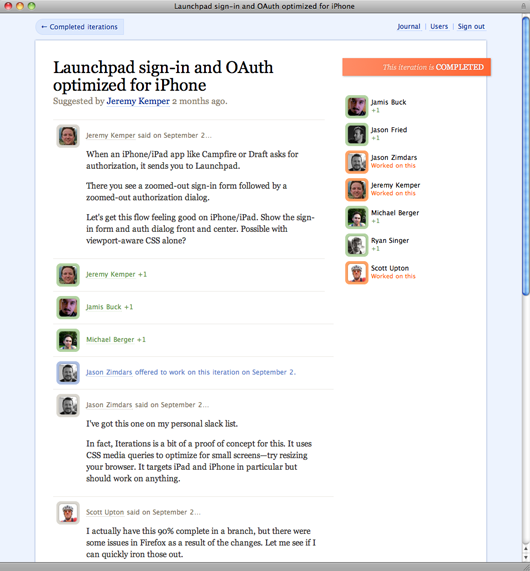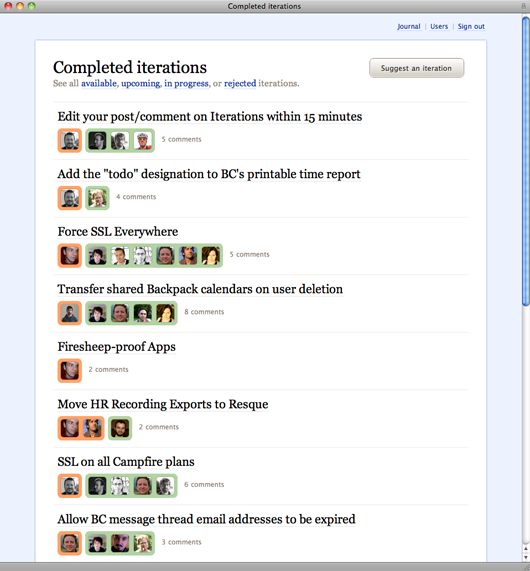At TEDxMidwest, Jason explains why the office isn’t a good place to get work done. He lays out some of the main problems and offers three suggestions to make work, well, work.
Signal v. Noise: Business
Start with our Best Hits on Business
- ⋆ When culture turns into policy
- ⋆ Some advice from Jeff Bezos
- ⋆ Video: Cool example of customers innovating behind…
- ⋆ Backstage: An inside look at how we use Basecamp
- ⋆ The Slicehost Story
- ⋆ Bootstrapped, Profitable, & Proud: GeekDesk
- ⋆ Every Bootstrapped, Profitable, & Proud in one place
- ⋆ Quote: Spinfree had a dirty little secret: It wasn…
- ⋆ How Intellum switched from making a plan for VCs to making a product for customers
- ⋆ Forget passion, focus on process
Our Most Recent Posts on Business
The number one competitor we have in our business is not Microsoft, Google, or some other startup somewhere. The number one competitor we have is simple things, like email…
People are organizing through email. They’re keeping track of their notes through email. They’re doing all this stuff through email. And email is incredibly simple, basically just a text box that you can send to other people or receive.
We have to be just one step above that. Most software developers in our space think they need to be far, far beyond that. The more complex they can be, the more features they list on the back of the box, the better it’s going to be — without realizing that’s not how most people operate. Most people operate just with email. So if we can just be one step above that, then we’re doing pretty well.
Audio of DHH speaking to A Better Way Of Work on the theme of simplicity
[Podcast] Episode #23: The 37signals Suite
Time: 09:56 | 11/22/2010 | Download MP3
Summary
Jason and David discuss the new 37signals Suite, how its price was set, and how the project fit into our two-week iteration method of working.
More episodes
Subscribe to the podcast via iTunes or RSS. Related links and previous episodes available at 37signals.com/podcast.
The things you do more often are the things you’re going to get good at. So if you get really good at spending money, you’re going to be really good at spending money. If you have to work on making money from day one, you’re going to get really damn good at making money. And that’s what you need to be as an entrepreneur…
The problem I have is when companies’ business model is free only. And then they say, “We’ll figure out how to make money later.” As if there’s going to be this magic switch they can flip…If you’re not practicing making money, you’re not going to be able to flip that switch and just know how to do it really well. You need to have some time. You need to have some experience at making money.
The story of Polaroid inventor Edwin Land, one of Steve Jobs' biggest heroes
One of Steve Jobs’ biggest heroes is Edwin Land, the inventor of Polaroid. Former Apple CEO John Sculley describes a meeting they had years ago and how both Land and Jobs felt that products existed all along — they just needed to discover them.
Dr Land was saying: “I could see what the Polaroid camera should be. It was just as real to me as if it was sitting in front of me before I had ever built one.”
And Steve said: “Yeah, that’s exactly the way I saw the Macintosh.” He said if I asked someone who had only used a personal calculator what a Macintosh should be like they couldn’t have told me. There was no way to do consumer research on it so I had to go and create it and then show it to people and say now what do you think?”
Both of them had this ability to not invent products, but discover products. Both of them said these products have always existed — it’s just that no one has ever seen them before. We were the ones who discovered them. The Polaroid camera always existed and the Macintosh always existed — it’s a matter of discovery. Steve had huge admiration for Dr. Land. He was fascinated by that trip.
John Byrne, who worked with Sculley on his book, offers additional details on that meeting and Jobs’ reaction.
Sitting in Land’s laboratory, Jobs found the great inventor and management thinker in a generous mood. “The world is like a fertile field that’s waiting to be harvested,” Land said. “The seeds have been planted, and what I do is go out and help plant more seeds and harvest them.”
Riding back to a nearby hotel in a taxi, Jobs turned to Sculley and said, “Yeah, that’s just how I feel. It’s like when I walk in a room and I want to talk about a product that hasn’t been invented yet. I can see the product as if it’s sitting there right in the center of the table. What I’ve got to do is materialize it and bring it to life, harvest it, just as Dr. Land said.”
“The world is like a fertile field that’s waiting to be harvested. The seeds have been planted, and what I do is go out and help plant more seeds and harvest them.” -Edwin Land
So just who was Edwin Land? The instant camera made him famous, but he invented much more than that.
Blinded by the lights
 In 1926, Land was a Harvard student walking along Broadway in New York City. He was overwhelmed by the glare from the headlights and store signs. He sensed a safety hazard and wondered if polarized lights could reduce that danger. He dropped out of school and began doing research at the New York Public Library. Eventually, he found a laboratory at Columbia University whose window was regularly unlocked. He would climb in at night and conduct experiments. He designed the first inexpensive light polarizing filters and eventually returned to Harvard and was provided a lab to do further research.
In 1926, Land was a Harvard student walking along Broadway in New York City. He was overwhelmed by the glare from the headlights and store signs. He sensed a safety hazard and wondered if polarized lights could reduce that danger. He dropped out of school and began doing research at the New York Public Library. Eventually, he found a laboratory at Columbia University whose window was regularly unlocked. He would climb in at night and conduct experiments. He designed the first inexpensive light polarizing filters and eventually returned to Harvard and was provided a lab to do further research.
The business media loves zeros
Pulse is raising $800,000 in venture capital. According to the New York Times, this is “the first step in moving along the path from building an app to running a profitable business.” So the first step to becoming profitable involves taking funding? Marco Arment ain’t having it.
It’s ridiculous, incorrect, and insulting to those (like me) who have chosen the traditional business model — charge money, spend less than you make — for this author suggest that giving away your product for free and paying your expenses with VC money is the “first step” to make your app development “a profitable business”.
The attitude of that Times piece is representative of a bigger problem with the business media. Reporters and magazines are in love with the sexiness of BIG NUMBERS! The more zeros, the better. Is it a round of funding or actual profit? Doesn’t matter. Is there actually a sustainable business underneath all those zeros? Doesn’t matter. By the time the reality of the situation comes to light, they’ve moved on to the next lottery winner/victim.
Case in point: “Digg makes $60,000,000 in 18 months!” is a cover story. But how much attention is paid when the company eventually lays off 37% of its staff while struggling to reach profitability? And you don’t often see a cover story with the headline “Funded Company Gets Sideways with Investors and Winds Up Going Under.” That’s just mundane, commonplace reality. Yawn.
And then you’ve got the blogs that track who got funding and what round they’re on. People follow along as if it all means something. In reality, it’s just scoreboard watching that’s more titillating than valuable.
While it’s easy to blame the media, they’re just playing this big numbers game because it works. People keep buying into the lottery winners plotline so the media keeps rolling it out. Circulation and traffic matters more than the truth. And as long as our startup culture keeps buying into the fantasy, the media will keep selling us zeros.
Iterations, a new internal app for managing what we work on next
What should we work on next and who’s going to do it? We recently created a new internal app called Iterations to answer that question. It’s for 1) managing our internal requests about which features/bugs to work on next and 2) helps us create teams/iterations to get them done (using our team-based way of working).
 A completed feature request.
A completed feature request.
The problem
Before Iterations, we kept ideas for what to do next all over the place: in our heads, dumped into Backpack, on pet lists kept individually, in Campfire team rooms, etc.
Even when we did manage to collect ideas, the list(s) would quickly become unmanageable. Ideas ranged from tiny fixes to large-scale multi-term projects. It wasn’t clear who added each idea, and many were in the form of feature requests — not scoped to an iteration.
Collecting ideas
So we made Iterations in order to create an easy place to jot down a quick idea — even if it isn’t fully formed — and then let a team build on it from there. Iterations would also make it easier to expose small, slack-type projects that are ripe for doing when someone has a short window of downtime.
 Viewing multiple requests at once. In this case, it’s completed items.
Viewing multiple requests at once. In this case, it’s completed items.
Another round of lessons learned from our new team-based way of working
Back in January, we began working in teams.
A team is made of three people: One designer and two programmers. A system administrator will also assist the team when necessary…
Each team will stay together for two months (a “term”). When two months are up, the teams split up and form again with different people. This way everyone gets to work with everyone else…
During the two month term, there will be four iterations. An iteration lasts for two weeks. An iteration can tackle one feature, a variety of smaller features, or part of a bigger feature that will require multiple iterations to complete.
It went well and we’ve stuck to this model while also evolving it along the way. This two-month recap offered up the results of the first term and some lessons learned. For example:
Lesson: Get out the scope hammer early and often
For two week iterations, true scope should be nailed down no later than half-way through. We found ourselves up against the wall a few times because we didn’t cut scope early enough. So we decided that on Monday of the second week we’ll review the work done during the previous week and the work remaining to complete the iteration. Since humans are notoriously bad estimators, we’ll be extra conservative with scope. We’ll bring out the hammer and beat down the scope. And then we’ll do it again on Wednesday, two days before the end of the iteration.
It’s now nine months later, so let’s check in again and see what else we’ve learned since then.
Lesson: Deploy is not the finish line
After an iteration is deployed, teams now go into a cooldown phase — something we didn’t have originally. This means team members go into support mode and deal with issues related to the deploy and any general concerns coming back from the Support team. That means fixing bugs, revising copy in the help section and/or email responses, and responding to queries at our Answers forum.
There’s no set length for this phase since you can’t plot exactly how it will play out. So we wait and see. We only assume the latest deploy is good to go once Support is in the clear for 6-12 hours. Then, and only then, is it time to move on to a new iteration.
Worth noting: It’s usually not a full court press on Support in this phase so this period also serves as a general cooldown and cleanup period. If one of the programmers is chasing an on-call issue, the other can refactor some code from the iteration that could be a general plugin. Meanwhile, the designer can help someone else explore an idea.
Lesson: Get away from calendar mode
We originally thought it best to have teams work strictly in two week iterations. But we’ve realized mapping iterations to calendar days causes problems. If you go from this Monday (the 1st) to that Monday (the 14th), you ignore vacations, holidays, summer schedules with 4-day workweeks, etc.
So we now measure iterations in number of working days. We’ll estimate how long it will take a team to finish a unit of work. If it’s seven working days and it’s during the summer, that means we’ll work on it Monday-Thursday (4 days) and Monday-Wednesday (3 days). We’ll then deploy on Wednesday night.
If something pops up that distracts the team for a day — say a major emergency or the need to help some other team out — everything just shifts forward a day. The deploy that was scheduled on Wednesday moves to Thursday. This means that iterations can end on any day of the week and start on any day of the week.
We noticed a similar issue with the length of team terms. It can be hard for a team to gel if it’s two-month term is during heavy vacation times (say, August or December). We’re now trying three-month terms to give teams more time to work together.
Lesson: Track your iterations
It’s important to stop and take a look back at how the time was spent. A term time card for a two-month term might look something like this:
Iteration 1: Estimated 7 days, actual days 7, quiet period 2 days
Iteration 2: Estimated 5 days, actual days 6, quiet period 1 days
Iteration 3: Estimated 10 days, actual days 9, quiet period 3 days
Iteration 4: Estimated 4 days, actual days 5, quiet period 3 days
When we look back at this time card, we see that Iteration 4 had the most problems. It was off a day and it had the longest quiet period relative to its duration. At that point, we know to dive in for closer review and see what caused issues with that iteration.
Lesson: Have a project “scribe”
At our last meetup, one of our Sys Admins expressed feeling out of the loop with the teams. Of course, we’re now at 20 people so no matter how we try, it’s going to be harder to keep the same intimate vibe we had when we were half that size. But we are taking steps to keep that tight-team feel whenever we can.
For one thing, we plan on meeting in person more often. The new office has helped spur more face-to-face meetings and trips to HQ for out-of-towners.
Also, we’ve added a role for project “scribe.” There’s one on each team and that person’s responsibility is to keep everyone else informed of what’s happening. The scribe posts a summary at the beginning and end of each iteration explaining what’s being tackled, what we got done, what issues arose, what delays occurred, etc. When everyone knows what’s going on with everyone else, the company feels more connected.
Continued…Bootstrapped, Profitable, & Proud: Admoda
This is part of our “Bootstrapped, Profitable, & Proud” series which profiles companies that have $1MM+ in revenues, didn’t take VC, and are profitable. Terry Jackson of Admoda responds in the comments section to reader questions.
One sign that Admoda, an ad network for mobile phones, is doing things a little bit differently: this press release announcing the company’s rejection of ”$25M of 3rd Round investment.”
Along with the angel investment of $250,000 that Admoda (and sister service Adultmoda) declined initially, the $3M in declined first round funding, and the $10M in declined second round funding, this latest round brings the total investment declined by Admoda to $38.25M…
Terry Jackson, CEO and founder of Admoda, had this to say, “Well, we did consider the traditional N step business plan of startups in the tech sector. But, in the end, we opted for a less-conventional, two-step plan; First, build a profitable business and grow it by re-investing the profits. Second … Sorry, did I say ‘two steps’? There’s just the one, actually.”
A fun little April Fool’s joke — but one inspired by frustration. “Many companies seem far more excited about sending out a press release regarding a round of funding then they would if they clinched a great sale or shipped a superb product,” explains Jackson when asked why the company posted the fake release. “It’s as if raising finance is the end goal for some businesses — like a prize or some kind of status symbol. It’s always press releases about VC funding too — I’ve noticed bank loans are not that cool. Investment is great if it is for the right reasons. But it should not be considered as a goal for a business in itself.”
How Admoda started
Back in 2002, Jackson founded MobVision, a group of businesses selling mobile content and mobile affiliation services. By 2005, he realized clients were struggling for ways to get traffic and thus the idea for Admoda sprouted. He felt that building an ad network for companies to buy and sell mobile traffic seemed a natural service to launch.
In 2006, Jackson (pictured at left) and co-founder David Salgado launched Admoda. It’s a global network run out of London, UK. There’s also a partner service called Adultmoda for mobile ad campaigns aimed at adults.
The founders started out with a set of goals: Bootstrap from the start, avoid the need for investment, provide a great service, build a great place to work, make a lot of money, and have fun. Jackson encourages other startups to also figure out their goals in the beginning. “Every founder should ask themselves: ‘What were the reasons I had for starting my business in the first place? What was I looking for from the business? What excited me? What drove me?’” he explains. “If those things are being achieved, or on their way to being achieved, then the business is successful.”
The founders funded themselves through their own cash, though they didn’t need much capital outlay at first. They launched Admoda as the most basic ad network companies could use to buy and sell traffic. Soon they made money and invested it back in.
The company has been profitable since shortly after launch and the number of ad requests per month has doubled in the last year, according to Jackson. The combined networks currently see over 7.5 billion ad requests per month. While Admoda is slightly larger, Adultmoda is the largest adult mobile ad network in the world.
Productivity as a measure of success
Profit is key, but Jackson feels productivity is also a good way to measure the success of a business. “We far outstrip the productivity of any of our competitors when you compare the volume of business our small team delivers compared to our larger VC funded competitors with their massive pools of staff and global offices,” he says.
Jackson feels using a company head count as something to brag about is ridiculous. (Admoda has a core team of only nine people.) “If you have the productivity to match the head count, great. But raising $40m and recruiting 85 employees does not constitute a good business — or a successful one.”
Exit strategy, or lack thereof
 Admoda isn’t interested in the acquisition game either. He says, “Virtually all mobile phone ad networks at the moment are raising investment, spending money, making a loss, and desperately trying to be acquired by someone with very deep pockets,” he says. “This is not a scenario that comes along and attacks from behind. Companies and the founders create their own destiny. Once you set off on the route of needing to make money you end up on a very different road than companies who don’t necessarily need to make money quickly because they have investment.”
Admoda isn’t interested in the acquisition game either. He says, “Virtually all mobile phone ad networks at the moment are raising investment, spending money, making a loss, and desperately trying to be acquired by someone with very deep pockets,” he says. “This is not a scenario that comes along and attacks from behind. Companies and the founders create their own destiny. Once you set off on the route of needing to make money you end up on a very different road than companies who don’t necessarily need to make money quickly because they have investment.”
Being funded by profit results in different choices. “We have to carefully decide where to channel our available resources,” he explains. “It also means we focus on making money rather than spending it, which requires a very different approach to business compared to many of our competitors. You can sense the desperation from some VC funded mobile advertising companies who are not yet acquired.”
We focus on making money rather than spending it, which requires a very different approach to business compared to many of our competitors.Continued…
Nordstrom's Employee Handbook — short and sweet
For years, Nordstrom’s Employee Handbook was a single 5×8” gray card containing these 75 words:
Welcome to Nordstrom
We’re glad to have you with our Company. Our number one goal is to provide outstanding customer service. Set both your personal and professional goals high. We have great confidence in your ability to achieve them.
Nordstrom Rules: Rule #1: Use best judgment in all situations. There will be no additional rules.
Please feel free to ask your department manager, store manager, or division general manager any question at any time.
During this time, Nordstrom had the highest sales per square foot performance in the retail industry – by almost double. [thx Ian]
